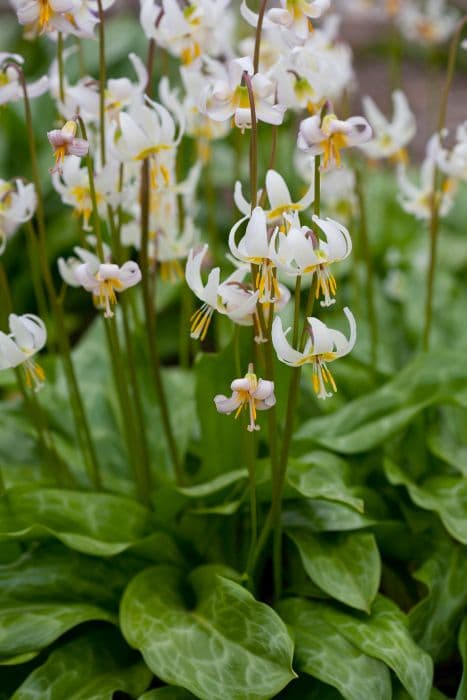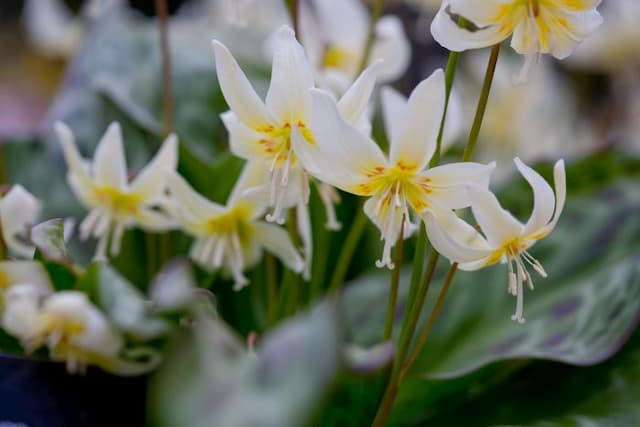Tulip Tulipa 'Daydream' (4)

ABOUT
Tulipa 'Daydream' is a stunning tulip variety known for its vibrant color and elegant form. Typically, it showcases a warm yellow hue, which can change to a delightful orange as the bloom matures and the flower experiences more sunlight. The tulip bears a classic cup shape that's synonymous with the essence of spring. Its petals are smooth and slightly pointed at the tips, which gently open wider as the flower comes into full bloom. The leaves are a lush green, providing a striking contrast against the vivid tones of the flower. The foliage is usually lance-shaped, adding texture and depth to the plant's appearance. This tulip makes for an eye-catching display in gardens or when cut for bouquets. Its transformative color and graceful silhouette can add a touch of whimsy and a splash of ever-changing color to any setting.
About this plant
 Names
NamesFamily
Liliaceae
Synonyms
Daydream Tulip
Common names
Tulipa 'Daydream'
 Toxicity
ToxicityTo humans
Tulip 'Daydream', commonly known as tulip, is not considered highly toxic to humans. However, ingestion of any part of the tulip can cause mild stomach upset, vomiting, and diarrhea. The bulbs contain allergenic lactones and can be more irritating than the flowers or leaves, potentially causing dizziness, fainting, or other neurologic and digestive symptoms if ingested in large quantities. Handling the bulbs may also cause allergic skin reactions in sensitive individuals.
To pets
The tulip 'Daydream', commonly referred to as the tulip, can be toxic to pets, especially cats and dogs, if ingested. The bulb contains the highest concentration of toxins, but all parts of the plant can be harmful. Symptoms of tulip poisoning in pets can include gastrointestinal upset, drooling, loss of appetite, or more serious effects such as depression of the central nervous system, convulsions, and cardiac abnormalities. Ingesting tulip bulbs can lead to more severe symptoms than eating the leaves or flowers.
 Characteristics
CharacteristicsLife cycle
Perennials
Foliage type
Deciduous
Color of leaves
Green
Flower color
Orange
Height
1-2 feet (30-60 cm)
Spread
3-6 inches (8-15 cm)
Plant type
Bulb
Hardiness zones
3
Native area
Central Asia
Benefits
 General Benefits
General Benefits- Enhances Landscape Aesthetics: Tulipa 'Daydream', commonly known as Daydream tulip, adds vibrant color and visual interest to gardens and landscapes.
- Attracts Pollinators: The bright flowers of the Daydream tulip attract bees and other pollinating insects, thereby supporting biodiversity.
- Easy to Grow: Daydream tulip bulbs are easy to plant and require minimal care, making them suitable for both novice and experienced gardeners.
- Spring Bloom Season: With its spring blooming season, the Daydream tulip provides early color to gardens after the winter months.
- Varied Landscaping Uses: They can be used in flower beds, borders, container gardens, and as cut flowers, offering versatility in landscaping design.
- Cultural Significance: As a member of the tulip family, Daydream tulips carry historical and cultural symbolism, representing perfect love and bringing a sense of tradition to gardens.
 Medical Properties
Medical PropertiesThis plant is not used for medical purposes.
 Air-purifying Qualities
Air-purifying QualitiesThis plant is not specifically known for air purifying qualities.
 Other Uses
Other Uses- The tulip 'Daydream' can be used as a natural dye for fabrics, offering colors ranging from soft yellows to intense oranges depending on the part of the plant used and the mordant.
- During events, these tulips can serve as a natural confetti alternative, with their petals being scattered to create a biodegradable and colorful effect.
- The petals of 'Daydream' tulips can be pressed and included in handmade paper, providing an attractive floral pattern to the finished product.
- Dried 'Daydream' tulip petals can be used in potpourri mixtures for their color and shape, adding an aesthetic element to the scent blends.
- Tulip 'Daydream' can be used as a learning tool in schools for botany lessons, teaching students about plant growth stages and bulb propagation.
- The bulbs of 'Daydream' tulips, when hollowed out carefully, can be transformed into tiny planters for succulents or other small plants.
- 'Daydream' tulip petals can be used in crafts, such as floral bookmarks or in resin jewelry, encapsulating the beauty of the flower in different forms.
- The strong stems of 'Daydream' tulips can be used as natural supports for other weaker-stemmed plants in the garden.
- When in bloom, 'Daydream' tulips can serve as a living art display in outdoor spaces, with creative arrangements amplifying the visual impact of their bright colors.
- Photographers can use 'Daydream' tulips as a subject for practicing macro photography and capturing the delicate textures and colors of the bloom.
Interesting Facts
 Feng Shui
Feng ShuiThe Tulip is not traditionally used in Feng Shui practice.
 Zodiac Sign Compitability
Zodiac Sign CompitabilityThe Tulip is not used in astrology practice.
 Plant Symbolism
Plant Symbolism- Growth: The tulip is often associated with rebirth and springtime, representing the idea of personal growth and the emergence of new possibilities.
- Love: Tulips, in general, symbolize perfect love, and giving a tulip is a message of deep, unconditional love.
- Royalty: Their elegant and poised appearance has made tulips symbolic of royalty and regal power.
- Prosperity: Tulips were the subject of a speculative frenzy now known as "Tulip Mania" in the 17th century, making them a historical symbol of wealth and prosperity.
 Water
WaterThe Daydream tulip requires consistent moisture during the growing season, especially when the shoots emerge and during flowering. Water your tulips deeply about once a week with 1 to 2 gallons per square yard, depending on rainfall and soil conditions. Ensure that the soil is well-draining to prevent the bulbs from rotting. After blooming, you can reduce watering as the foliage begins to die back. Over the summer, when the bulbs are dormant, less frequent watering or relying on natural rainfall is typically sufficient unless conditions are very dry.
 Light
LightDaydream tulips thrive in full sunlight, ideally receiving at least 6 hours of direct sun daily. The best spot for these tulips would be in an area where they can soak up the morning light while being protected from the intense heat of late afternoon sun in hotter climates. A location with bright but indirect light in the afternoon is ideal to prevent potential damage to the blooms.
 Temperature
TemperatureDaydream tulips prefer cool to moderate temperatures, with an ideal range between 55 to 65 degrees Fahrenheit. They can survive brief periods of colder weather down to around 20 degrees Fahrenheit and can handle springtime temperature fluctuations. However, extended exposure to heat above 70 degrees Fahrenheit after blooming can shorten the life span of the flowers and foliage.
 Pruning
PruningPruning of Daydream tulips typically involves deadheading the spent flowers after blooming to redirect energy to the bulbs rather than seed production. Cut back the flower stalks to the base of the plant, taking care not to damage the surrounding foliage. After the leaves yellow and wither, typically by late spring or early summer, they can be pruned away completely. Pruning is generally done once a year, after flowering.
 Cleaning
CleaningNot needed
 Soil
SoilThe best soil mix for Daydream tulips is well-drained, fertile soil with a neutral to slightly alkaline pH, ranging from 6.0 to 7.0. Incorporate organic matter to improve texture and nutrient content.
 Repotting
RepottingDaydream tulips are perennial and do not require frequent repotting. Instead, they should be lifted and divided every 3-5 years after the blooming and foliage fade.
 Humidity & Misting
Humidity & MistingDaydream tulips prefer moderate humidity levels, typical of outdoor conditions; they do not have specific humidity requirements but perform best with natural air circulation.
 Suitable locations
Suitable locationsIndoor
Plant in sunny spot with cool temp and well-drained soil.
Outdoor
Plant in well-drained soil, full sun, cool spring temperatures.
Hardiness zone
3-8 USDA
 Life cycle
Life cycleTulipa 'Daydream', commonly known as Daydream Tulip, begins its life cycle as a bulb planted in the fall, entering a dormant state through the winter. In early to mid-spring, the warmth and moisture trigger the growth of roots and shoots, with the plant emerging from the soil as temperatures rise. The stems elongate, and foliage develops, followed by the iconic flower bud that the tulips are known for. The Daydream Tulip's bud opens into a colorful bloom, typically in late spring, attracting pollinators such as bees. After pollination, the flower fades, the plant goes into senescence, and the foliage dies back, with energy being stored back in the bulb for the next season. The bulb then re-enters dormancy through the summer and autumn until the cycle begins anew with the next season's growth.
 Propogation
PropogationPropogation time
Spring
Tulipa 'Daydream', more commonly known as the Daydream tulip, is most effectively propagated by bulb division, which is generally done in the fall after the foliage has died back. To propagate by bulb division, carefully dig up the tulip bulbs and gently separate any small bulblets that have formed at the base of the mother bulb. These bulblets will eventually mature into full-size bulbs over the course of a few growing seasons. It is important to handle them with care to prevent damage. After separating, the bulbs and bulblets should be planted immediately in well-drained soil at a depth three times the height of the bulb, approximately 6 to 8 inches apart to allow for proper growth and root development. This method leverages the plant's natural reproductive cycle and ensures that the genetic traits of the Daydream tulip are precisely retained in the new plants.








